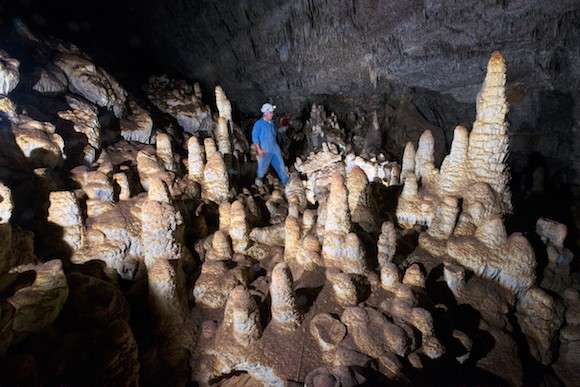February 9, 2016 report
Underground formations reveal wet past of Australia's Nullarbor Plain

(Phys.org)—A team of researchers affiliated with several institutions in Australia has found evidence that suggests that a desert region in Australia experienced a relatively short burst of wetter weather approximately five million years ago. The team has published a paper in Proceedings of the National Academy of Sciences detailing their study of stalagmites and stalactites in caves in the area and why they believe what they found might give a hint of what the future holds for Australia.
Prior research has shown that the Nullarbor Plain, which lies near the southern edge of the middle of the country, has been drying out for approximately 14 million years. It was prior to that time that underground caves formed, capturing, the researchers report, evidence of climate changes.
In their study, the researchers looked at stalagmites and stalactites in which minute amounts of pollen had been captured due to air circulating in from aboveground. In studying the pollen and comparing it with the ages of material in which they were embedded, the researchers were able to show that there was a pause in the long slow drying period during which things grew considerably wetter. Approximately five million years ago, they claim, rain in the area increased so much that the area became part of a rain forest. And it happened very quickly, geologically speaking, in a matter of just 100,000 years. That period, the team reports, lasted for approximately two millions years—after that the area returned to its dryer pattern that led to the weather in the area today—the Nullarbor Plain gets just 3cm of rain on average per year.
To explain the suddenly wetter conditions, the researchers point to other research that has shown that ocean temperatures rose just prior to the short wet period, and that led to a fourfold increase in rainfall in parts of Australia, which led to a transformation in the types of plants growing in some areas. The oceans warmed, it is believed, due to unknown factors that caused global atmospheric warming. The researchers note that most scientists believe that the Earth will once again become as warm as it was during that period five million years ago, due to man-made causes, and thus, it appears likely parts of Australia are going to get a lot wetter in the not too distant future.
More information: Pliocene reversal of late Neogene aridification, PNAS, www.pnas.org/cgi/doi/10.1073/pnas.1520188113
Abstract
The Pliocene epoch (5.3–2.6 Ma) represents the most recent geological interval in which global temperatures were several degrees warmer than today and is therefore considered our best analog for a future anthropogenic greenhouse world. However, our understanding of Pliocene climates is limited by poor age control on existing terrestrial climate archives, especially in the Southern Hemisphere, and by persistent disagreement between paleo-data and models concerning the magnitude of regional warming and/or wetting that occurred in response to increased greenhouse forcing. To address these problems, here we document the evolution of Southern Hemisphere hydroclimate from the latest Miocene to the middle Pliocene using radiometrically-dated fossil pollen records preserved in speleothems from semiarid southern Australia. These data reveal an abrupt onset of warm and wet climates early within the Pliocene, driving complete biome turnover. Pliocene warmth thus clearly represents a discrete interval which reversed a long-term trend of late Neogene cooling and aridification, rather than being simply the most recent period of greater-than-modern warmth within a continuously cooling trajectory. These findings demonstrate the importance of high-resolution chronologies to accompany paleoclimate data and also highlight the question of what initiated the sustained interval of Pliocene warmth.
Journal information: Proceedings of the National Academy of Sciences
© 2016 Phys.org




















